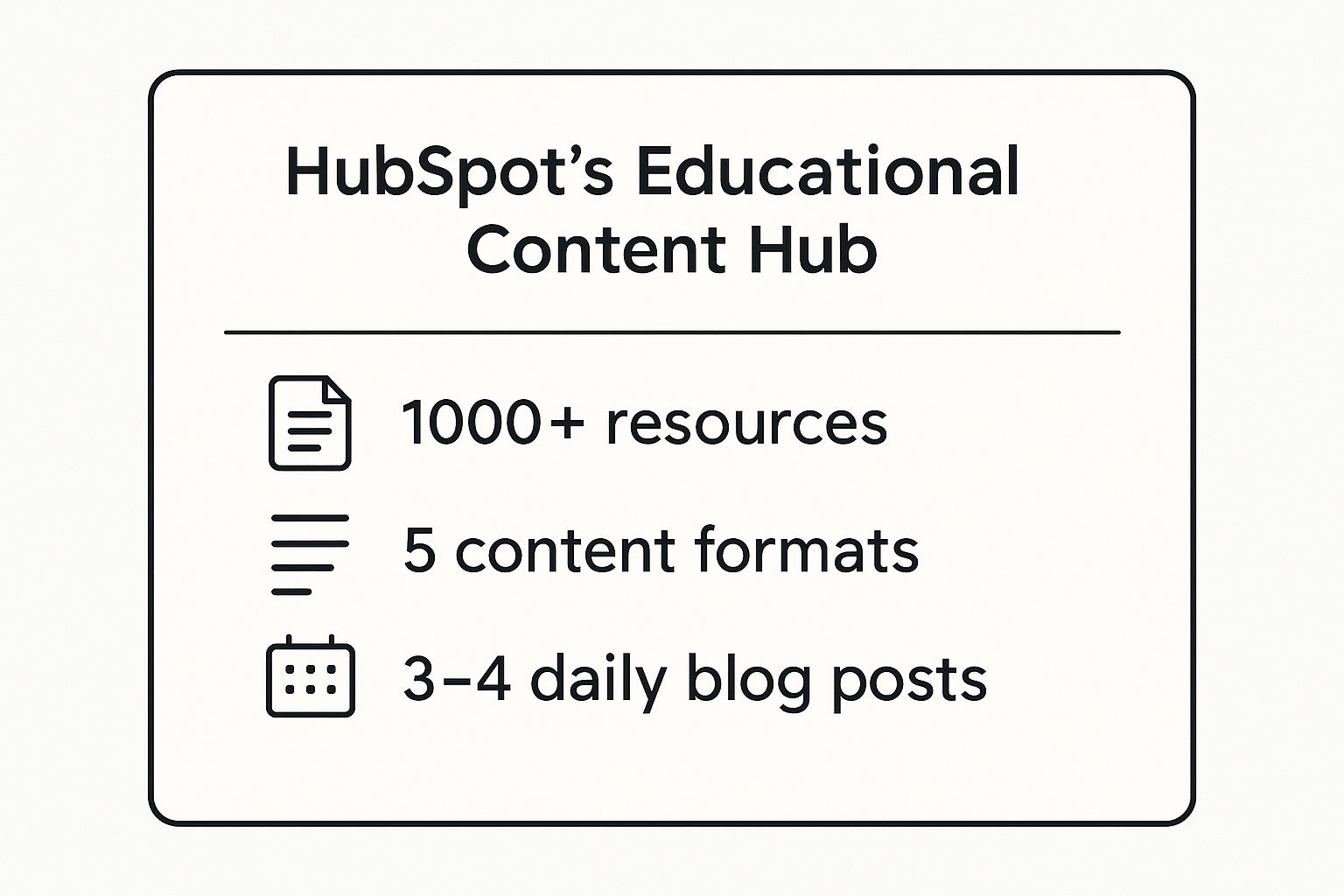8 Unbeatable Content Marketing Strategy Examples for 2025

Content marketing is more than just blogging or posting on social media; it's a strategic engine for growth that connects directly with your audience. But what does a truly effective content marketing strategy look like in the wild, and how can you replicate that success? This article moves past generic advice and buzzwords to deconstruct the specific frameworks behind brands that have mastered connection, engagement, and conversion.
We will dissect powerful content marketing strategy examples from companies like Patagonia, HubSpot, and Netflix. You'll gain a behind-the-scenes look at their methods, from user-generated content campaigns and data-driven personalization to educational hubs and viral video launches. Instead of just admiring their success, we will break down the precise tactics they used and provide actionable takeaways you can apply.
Get ready to learn not just the 'what' but the crucial 'how' and 'why' behind these winning approaches. Each example serves as a practical blueprint, offering replicable methods to help you build a content machine that delivers measurable results. We're getting straight to the point, providing the strategic insights needed to transform your own content efforts.
1. HubSpot's Educational Content Hub
When it comes to comprehensive, education-first content marketing strategy examples, HubSpot wrote the book. Their entire business model is built on providing immense value upfront, positioning themselves as the definitive resource for marketing, sales, and customer service professionals. This approach, known as inbound marketing, attracts potential customers by creating helpful content and experiences tailored to them.
HubSpot’s strategy is a masterclass in covering the entire customer journey. They don't just write blog posts; they build a complete educational ecosystem. This includes the renowned HubSpot Academy with free courses and certifications, a library of downloadable templates and ebooks, and free tools like the Website Grader.
Strategic Breakdown
HubSpot’s success isn't accidental; it’s the result of a meticulously planned and executed strategy. Their approach is built on the "topic cluster" model, where a central "pillar page" covers a broad topic, and multiple "cluster" content pieces link back to it, strengthening its authority.
- Pillar Content: Long-form, authoritative guides like "The Ultimate Guide to Content Marketing."
- Cluster Content: More specific blog posts, such as "How to Create a Content Calendar" or "10 Blog Post Templates," that all link back to the main pillar page.
- Lead Generation: Every piece of content offers a "content upgrade," like a free template or checklist, in exchange for an email address. This turns passive readers into active leads.
This structure allows them to dominate search engine rankings for thousands of keywords while systematically guiding users from awareness to consideration.
The following infographic highlights the sheer scale and consistency of HubSpot's content production.

The scale shown here demonstrates a core principle: consistency and volume at high quality build an impenetrable moat of authority and organic traffic. This level of output requires a highly organized system. You can learn more about building a system like this by reviewing a detailed content marketing workflow that supports such a strategy.
Actionable Takeaways
- Start with a Pillar Page: Identify a core topic your audience cares about and create a comprehensive guide.
- Build Your Cluster: Develop a list of related, more specific subtopics to create as blog posts, videos, or infographics that link back to your pillar page.
- Create Content Upgrades: For your most popular posts, offer a related, high-value resource (like a checklist or template) to capture leads.
- Repurpose and Update: Regularly refresh your top-performing content and repurpose it into different formats (e.g., turn a blog post into an infographic or video script).
2. Dollar Shave Club's Viral Video Marketing
Dollar Shave Club burst onto the scene by weaponizing humor and relatability, proving that a brilliant video-first content marketing strategy can disrupt an entire industry. Instead of focusing on technical specs, their strategy revolves around creating wildly entertaining, shareable videos that build a strong brand personality and connect with audiences on an emotional level. This approach cut through the noise of a market dominated by legacy brands.
Their launch video, "Our Blades Are F***ing Great," wasn't just an ad; it was a cultural moment. It perfectly blended a clear value proposition (affordable, quality razors delivered to your door) with a raw, authentic, and hilarious delivery that resonated instantly with its target demographic. This set the tone for all future content, from their "Bathroom Minutes" series to comedic product demos.

Strategic Breakdown
Dollar Shave Club’s success demonstrates how brand storytelling can be more powerful than a massive advertising budget. Their strategy was built on authenticity and a deep understanding of their audience’s pain points and sense of humor, turning mundane products into a compelling narrative.
- Personality-Driven Content: The founder, Michael Dubin, starred in the launch video, establishing a relatable, anti-corporate persona that became the brand's voice.
- Problem-Solution Through Entertainment: Their content masterfully addresses common frustrations with buying razors (high cost, inconvenience) but wraps the solution in comedy, making the message memorable and shareable.
- Focus on Virality: Videos were crafted to be short, punchy, and perfect for social media sharing. The humor and shock value were engineered to generate organic buzz and word-of-mouth marketing.
By prioritizing entertainment and personality, they built a loyal community that felt like they were part of an exclusive club, not just customers of a razor company.
Actionable Takeaways
- Define Your Brand Persona: What is your brand's unique voice? Is it witty, authoritative, or quirky? Embody it in your content.
- Lead with Entertainment, Follow with Value: Capture attention with humor or a compelling story before presenting your product's benefits.
- Address a Real Pain Point: The most effective content solves a problem. Identify a frustration your audience has and address it head-on.
- Optimize for Sharing: Create content that people will want to send to their friends. Keep videos concise and include a surprising or hilarious element.
3. Airbnb's User-Generated Content Strategy
Airbnb masterfully demonstrates how to build a global brand on the foundation of trust and authenticity, powered almost entirely by its community. Their content marketing strategy examples showcase the power of user-generated content (UGC), turning everyday hosts and guests into their most compelling storytellers. This approach not only generates a massive, low-cost library of content but also provides the social proof necessary to thrive in the sharing economy.
Instead of relying on polished, corporate marketing, Airbnb amplifies the real experiences of its users. This is seen in everything from guest photos and reviews to detailed Neighborhood Guides created by local hosts. This strategy transforms their platform from a simple booking site into a vibrant community where potential travelers can see and feel what an experience will be like through the eyes of those who have been there.

Strategic Breakdown
Airbnb’s UGC success is built on creating a framework that encourages and elevates community contributions, making them central to the marketing flywheel. They don't just ask for content; they integrate it directly into the user experience, making it both a discovery tool and a trust signal.
- Social Proof as a Core Feature: Guest reviews and photos are not just an add-on; they are a fundamental part of each listing, directly influencing booking decisions.
- Empowering Local Experts: Host-created Neighborhood Guides provide invaluable local insights that a corporate team could never replicate, adding immense value and authenticity.
- Multi-Channel Amplification: Top-tier UGC, like stunning travel photos from the #AirbnbExperience hashtag or compelling guest stories, is curated and featured across their high-traffic social media channels and blog.
This strategy effectively outsources content creation to the most credible source possible: the customers themselves. Building a community that advocates for you requires a strong understanding of user motivation, a topic covered extensively in discussions about social media marketing for authors and other creator-centric fields.
Actionable Takeaways
- Create Clear Contribution Guidelines: Make it easy for users to submit content by providing simple instructions, prompts, and examples.
- Incentivize with Recognition: Feature the best user content prominently on your website, social media, or email newsletters. Public recognition is a powerful motivator.
- Launch a Branded Hashtag: Create a unique hashtag (like #AirbnbExperience) to easily collect and curate user content from social platforms.
- Integrate UGC into the Customer Journey: Use authentic user photos and reviews at key decision-making points, such as on product pages or at checkout, to build confidence.
4. GoPro's Adventure-Focused Visual Storytelling
GoPro didn't just sell a camera; it sold a lifestyle. Its content marketing strategy is a prime example of turning customers into a powerful, organic marketing engine. By focusing on user-generated content (UGC), GoPro built a brand synonymous with adventure, action, and breathtaking moments, all captured by the very people using their products. This approach creates authentic social proof on a massive scale.
The strategy brilliantly showcases the product's capabilities without hard-selling. Instead of telling you what the camera can do, GoPro shows you, using stunning videos and photos from its global community. This creates a powerful cycle: users share incredible content, which inspires others to buy a GoPro and create their own, feeding an ever-growing library of aspirational marketing assets.
Strategic Breakdown
GoPro’s success hinges on making its customers the heroes of the story. The company built a community-centric ecosystem designed to encourage, collect, and celebrate user content, effectively outsourcing its content creation to its most passionate advocates.
- Incentivize Creation: The GoPro Awards program offers cash prizes and gear for standout photos, raw clips, and video edits, directly motivating users to submit their best work.
- Curate and Amplify: GoPro's social media channels, particularly YouTube and Instagram, act as a global stage, featuring a "Photo of the Day" or "Video of the Day" from users. This gives creators massive exposure and reinforces the brand's community focus.
- Hybrid Content Model: While UGC is the core, GoPro complements it with professionally produced content featuring sponsored athletes and adventure documentary series. This adds a layer of polish and aspirational quality that elevates the entire brand.
This UGC-first model not only generates a vast and diverse content pipeline but also builds an incredibly loyal community that feels seen and valued by the brand.
Actionable Takeaways
- Launch a UGC Program: Create a branded hashtag and a clear submission process. Offer incentives like prizes, discounts, or a feature on your official channels to encourage participation.
- Set Quality Standards: While embracing authenticity, establish clear guidelines for the type of content you want to feature to ensure it aligns with your brand's image.
- Celebrate Your Community: Always credit creators and make them feel like a core part of your brand. Tagging them and celebrating their work fosters loyalty and encourages more submissions.
- Maintain a Consistent Cadence: Regularly feature user content (e.g., daily or weekly) to build audience anticipation and keep your community engaged.
5. Netflix's Data-Driven Personalized Content
Netflix has transformed content marketing from a one-to-many broadcast into a deeply personal one-to-one conversation. Its strategy is the pinnacle of data-driven personalization, using sophisticated analytics to tailor every aspect of the user experience. By meticulously tracking viewing habits, search queries, and even pause-and-rewind moments, Netflix doesn’t just suggest what to watch next; it curates an entire entertainment universe unique to each subscriber.
This hyper-personalization is one of the most powerful content marketing strategy examples because it directly addresses user retention. The platform’s goal is to make its service so indispensable and intuitive that leaving feels like a downgrade. From dynamically changing a show's thumbnail based on your viewing history to creating custom trailers, Netflix’s content is its marketing, engineered to maximize engagement and minimize churn.
Strategic Breakdown
Netflix's success is rooted in its ability to turn massive datasets into actionable, personalized content experiences. The strategy goes far beyond simple recommendations and touches every part of the user journey, ensuring the right content finds the right viewer at the right time. This is achieved through a multi-layered, systematic approach to data application.
- Algorithmic Curation: The core of the strategy is the recommendation engine, which analyzes user data to populate the homepage with relevant genres, shows, and films.
- Dynamic Artwork: Netflix tests thousands of variations of artwork for a single title, showing different images to different user segments to see which one drives the most clicks. A user who watches many action films might see a thumbnail for a drama highlighting its action-heavy scenes.
- Personalized Marketing: Email campaigns and push notifications are highly targeted, often promoting new content based on a user's affinity for a specific actor, director, or genre.
This system ensures that the platform feels fresh and relevant every time a user logs in, creating a powerful feedback loop where more viewing generates better data, which in turn leads to even more precise personalization.
Actionable Takeaways
- Start with Basic Segmentation: You don't need Netflix's budget to start. Begin by segmenting your audience based on simple behaviors (e.g., first-time visitors vs. repeat customers) and tailor your content accordingly.
- Test Personalization Elements: Systematically test different elements. Experiment with personalized email subject lines, different calls-to-action on your website, or unique content offers for various audience segments.
- Balance Personalization with Discovery: While personalization is key, don't create an echo chamber. Ensure users can still discover new topics and products outside their immediate interest profile to broaden their engagement.
- Be Transparent with Data: Clearly communicate how you are using user data to improve their experience. Building trust is essential for any long-term personalization strategy. Just as with book promotion, a clear and honest approach builds a loyal following. You can review similar engagement principles in these effective book marketing strategies.
6. Patagonia's Environmental Activism Content
Patagonia has pioneered a content marketing strategy that is less about selling products and more about advancing a mission. Their approach centers entirely on environmental activism and corporate responsibility, creating content that reinforces their core value: "We're in business to save our home planet." This builds profound brand loyalty with consumers who share these values.
Instead of traditional product-focused marketing, Patagonia produces documentary films, publishes books, and runs activism-focused campaigns. Initiatives like their famous "Don't Buy This Jacket" ad on Black Friday or their "The Footprint Chronicles" supply chain transparency tool are powerful content marketing strategy examples that prioritize purpose over immediate profit, creating a fiercely loyal community.
Strategic Breakdown
Patagonia’s strategy is a masterclass in authentic, mission-driven marketing. It succeeds because their content is a direct extension of their business practices, not just a marketing layer. They take genuine action, and their content simply tells that story.
- Value-Driven Storytelling: Content is never just about gear; it's about the environmental issues connected to the places where that gear is used. Films like Artifishal don't promote jackets, they critique fish hatcheries.
- Activism as Content: Campaigns are designed to spur action. Their Worn Wear program, which promotes repairing and reusing gear, is a powerful content platform that directly challenges consumerism.
- Radical Transparency: The Footprint Chronicles offers a transparent look into their supply chain, building trust by openly sharing both the good and the bad. This honesty serves as compelling, authority-building content.
This approach transforms customers into advocates. By taking a stand, Patagonia creates a brand that people are proud to associate with, turning every piece of content into a statement of shared values.
Actionable Takeaways
- Define Your Core Mission: What does your brand stand for beyond its products? Build your content strategy around that central purpose.
- Take Action First: Your content will only be authentic if it reflects real-world actions. Donate, volunteer, or change your business practices before you start marketing it.
- Educate, Don't Just Sell: Focus your content on teaching your audience about the issues you care about. This builds a deeper connection than a simple sales pitch.
- Embrace Controversy (Authentically): If your mission involves taking a stand, don't be afraid to be bold. True fans will respect your conviction.
7. Coca-Cola's Emotional Brand Storytelling
Coca-Cola’s content marketing strategy is a masterclass in forging deep emotional connections with a global audience. Instead of focusing on product features, the company’s content consistently revolves around universal themes of happiness, togetherness, and shared human experiences. This approach transforms the beverage from a simple product into a powerful symbol of joy and connection.
Their strategy transcends traditional advertising by creating immersive brand stories that resonate on a personal level. Campaigns like "Share a Coke" or the annual "Holidays are Coming" Christmas truck commercials are not just ads; they are cultural events. They position Coca-Cola as an integral part of life’s most cherished moments, making the brand synonymous with positive feelings.
Strategic Breakdown
Coca-Cola's success is rooted in its ability to tell stories that evoke strong, positive emotions, which consumers then associate with the brand itself. This is one of the most powerful content marketing strategy examples for building long-term brand loyalty. They focus on moments, not ingredients.
- Universal Themes: Campaigns are built on relatable emotions and experiences like friendship ("Share a Coke"), holiday magic ("Holidays are Coming"), and unity ("Taste the Feeling").
- High-Impact Storytelling: They invest heavily in high-quality production to create cinematic, emotionally charged content that feels more like a short film than a commercial.
- Multi-Channel Integration: The core story is adapted and amplified across all channels, from television and print to social media and experiential events, creating a cohesive brand narrative.
This strategy ensures that Coca-Cola remains culturally relevant by attaching its identity to timeless human values rather than fleeting product trends.
Actionable Takeaways
- Focus on Feelings, Not Features: Identify the core emotions your product or service enables for customers and build your stories around those feelings.
- Tell Universal Stories: Create content centered on universal human experiences like celebration, friendship, or overcoming challenges to broaden your appeal.
- Invest in Quality: High-quality visuals and sound are crucial for creating a strong emotional impact. Your production value should match the emotion you want to evoke.
- Adapt Globally, Act Locally: While your core emotional theme can be universal, tailor the execution to resonate with local cultures and customs, as seen in the "Share a Coke" campaign's regional name variations.
8. IBM's Thought Leadership Through Research and Insights
IBM solidifies its authority in the B2B technology space not by selling products directly, but by selling expertise. Their content marketing strategy is a prime example of building thought leadership through deep, research-driven insights. Instead of just blogging about tech trends, IBM invests heavily in producing original research and comprehensive reports that define industry conversations.
This approach targets high-level decision-makers by addressing their most significant challenges with credible, data-backed analysis. Through initiatives like the IBM Institute for Business Value and publications like Think Magazine, IBM provides a forward-looking perspective on everything from AI and quantum computing to business transformation. This positions them as an indispensable strategic partner, not just a vendor.
Strategic Breakdown
IBM's strategy is built on a foundation of intellectual capital. They create high-value assets that command attention in the C-suite and among technical leaders, influencing purchasing decisions long before a sales conversation begins. Their method is systematic and authoritative.
- Original Research: They conduct and publish major studies, like their global C-suite studies, that survey thousands of executives. This provides unique data points no one else has.
- Accessible Insights: Complex research is distilled into accessible formats, including executive summaries, whitepapers, and articles, tailored for a business audience. For example, their insights on Watson AI are presented through tangible case studies and industry-specific applications.
- Multi-Channel Distribution: Content is not just published on their site; it's actively promoted across professional networks like LinkedIn, featured in major business publications, and discussed at industry events, maximizing its reach and impact.
This framework allows IBM to shape market understanding and guide strategic planning within their target organizations, making their solutions a natural fit for the problems they've helped define.
Actionable Takeaways
- Invest in Original Data: Commission a survey or study on a key challenge in your industry. Original data is a powerful asset for generating backlinks and media mentions.
- Solve Executive-Level Problems: Frame your content around strategic business problems, not just product features. Address topics like risk management, growth, and operational efficiency.
- Make Complexity Clear: Break down highly technical or complex subjects into clear, concise takeaways for busy decision-makers. Use analogies, visuals, and executive summaries.
- Become the Source: Consistently publish high-quality, original research to become the go-to source for industry trends and data. This builds immense long-term authority.
Content Marketing Strategy Examples Comparison
| Strategy | Implementation Complexity 🔄 | Resource Requirements ⚡ | Expected Outcomes 📊 | Ideal Use Cases 💡 | Key Advantages ⭐ |
|---|---|---|---|---|---|
| HubSpot's Educational Content Hub | High – multi-format, topic clusters | High – content creators, SEO, experts | Scalable lead generation, thought leadership | B2B lead generation, long-term SEO strategy | Strong credibility, consistent publishing, SEO |
| Dollar Shave Club's Viral Video | Medium – creative talent and video production | Medium – video production, creative team | High brand awareness, viral reach | Brand personality building, customer acquisition | Emotional connection, cost-effective viral growth |
| Airbnb's User-Generated Content | Medium – community management, moderation | Low to Medium – user participation focus | Authentic trust, social proof | Community-driven trust, scalable content | Cost-effective, diverse perspectives, engagement |
| GoPro's Adventure Visual Storytelling | Medium – UGC curation, partnerships | Medium – content curation, athlete collaborations | Product demo, community building | Adventure sports, aspirational branding | Authentic demos, strong community, high engagement |
| Netflix's Data-Driven Personalization | High – advanced analytics, ML infrastructure | High – tech infrastructure, data scientists | Increased engagement, user retention | Personalized user experiences, reducing churn | Highly relevant UX, data-driven decisions |
| Patagonia's Environmental Activism | Medium – mission-driven, authentic content | Medium – storytelling, documentary production | Brand loyalty, purpose-driven customer base | Values alignment, environmental advocacy | Emotional connection, brand differentiation |
| Coca-Cola's Emotional Storytelling | High – high production, multi-channel | High – video production, experiential marketing | Strong emotional brand affinity | Global brand, experience-driven marketing | Universal appeal, premium branding |
| IBM's Thought Leadership Research | High – research intensive, technical focus | High – R&D, expert authors | Enterprise trust, industry influence | B2B, enterprise sales cycles, technology leadership | Credibility, detailed insights, trusted advisor |
From Inspiration to Implementation: Building Your Own Content Strategy
We've explored a powerful array of content marketing strategy examples, from HubSpot’s educational empire to GoPro’s community-driven visual storytelling. Each case study, whether it's Patagonia's mission-led activism or Netflix's data-fueled personalization, offers a blueprint for success. But what is the universal lesson that connects these diverse approaches? It’s the commitment to a core idea executed with unwavering consistency.
These brands didn't just create content; they built worlds around their audiences. They understood that effective marketing isn't about shouting the loudest. It’s about building trust, providing genuine value, and creating a memorable experience that resonates long after the initial interaction. Their success hinges on a clear, strategic foundation.
Distilling the Core Principles of Success
Looking back at the strategies of IBM, Airbnb, and others, several key principles emerge as non-negotiable for anyone looking to replicate their success. Mastering these concepts is the first step toward building a content engine that drives real results.
- Audience-Centricity: Every successful example started with a deep, almost obsessive, understanding of its target audience. They didn’t guess what their audience wanted; they listened, researched, and delivered content that addressed specific pain points, aspirations, and interests.
- Purpose-Driven Content: Whether the goal was to educate (HubSpot), entertain (Dollar Shave Club), or inspire (Patagonia), every piece of content had a clear and singular purpose that aligned with the overarching brand mission.
- Strategic Consistency: Success wasn't the result of a single viral video or a one-off campaign. It was built through the disciplined, consistent execution of their strategy over time, creating a reliable and recognizable brand presence.
Your Next Steps: From Strategy to Action
Translating these high-level content marketing strategy examples into a tangible plan can feel daunting, especially for authors and publishers with limited time and resources. Your manuscript is a goldmine of content, but manually extracting themes, quotes, and ideas for blogs and social media is a monumental task. The key is to find a system that bridges the gap between your brilliant book and your marketing execution.
Start by defining your primary goal. Do you want to establish yourself as a thought leader like IBM or build a passionate community like GoPro? Once your objective is clear, you can identify the content formats that best serve that goal. An author aiming for thought leadership might focus on creating insightful blog posts and data-driven articles, while one building a community could prioritize interactive social media content and user-generated story campaigns.
The crucial next step is to build a scalable workflow. This is where you can leverage technology to transform your core asset, your manuscript, into a diverse range of marketing materials. By automating the ideation and creation process, you free yourself to focus on the strategic elements: engaging with your audience, building relationships, and planning your next big project. This strategic automation is no longer a luxury; it’s a necessity for competing effectively and letting your stories shine.
Ready to turn your book into a powerful marketing engine? ManuscriptReport.com analyzes your manuscript and automatically generates a complete content marketing plan, from blog post ideas to social media campaigns. Stop brainstorming and start marketing by visiting ManuscriptReport.com to get your personalized report today.
